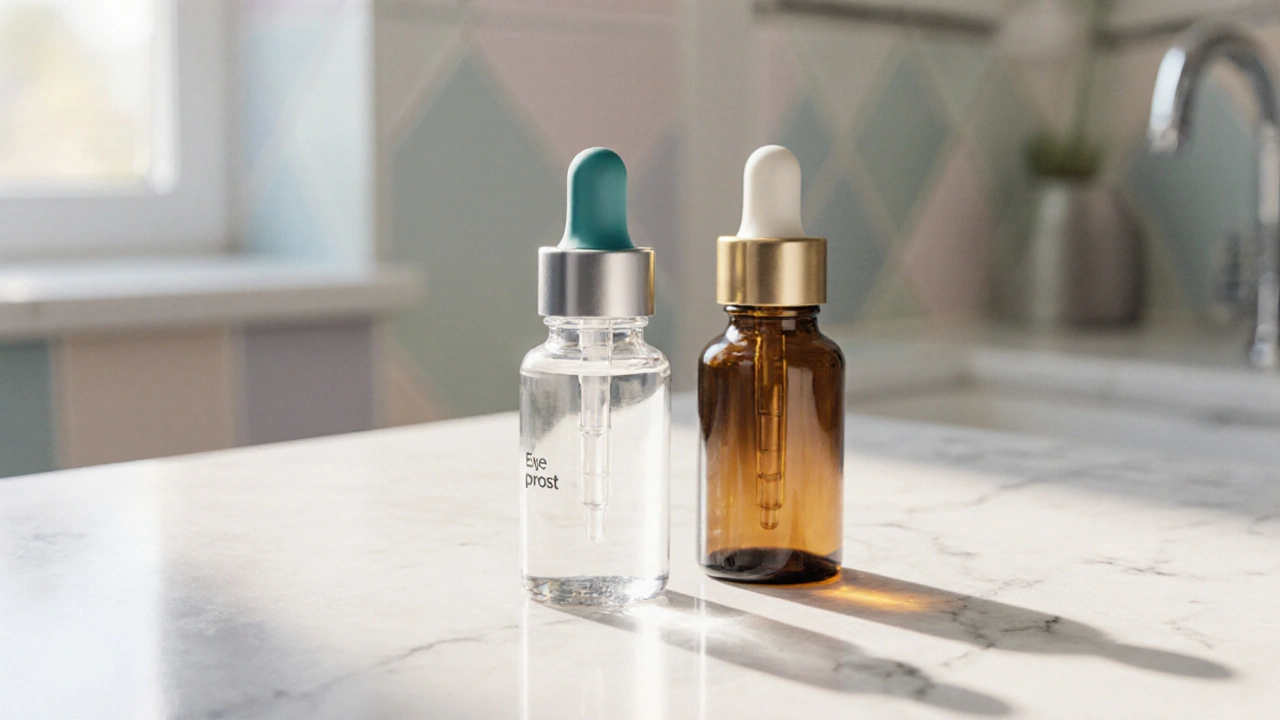Eyelash & Glaucoma Treatment Comparison Tool
Select Treatment Options to Compare
Careprost is a synthetic prostaglandin analog that contains the active ingredient bimatoprost 0.03% (or 0.01%). It is primarily marketed for cosmetic eyelash enhancement but also has FDA‑approved use in reducing intra‑ocular pressure for glaucoma patients. The formulation works by extending the anagen (growth) phase of hair follicles, resulting in longer, thicker lashes after several weeks of nightly application.
How Careprost Works - The Science Behind the Lash Boost
The active molecule, bimatoprost, mimics prostaglandinF₂α, a natural compound that regulates fluid dynamics in the eye. When applied to the eyelid margin, it binds to prostaglandin receptors (FP receptors) on the hair follicle cells, triggering a cascade that increases melanin production and prolongs the growth cycle. Clinical trials reported a 25‑35% increase in lash length after 12weeks, with an average gain of 1-2mm.
Key Benefits of Careprost Compared with Prescription Brands
- Cost‑effective: generic pricing is roughly 30% of branded equivalents.
- Convenient dosing: one drop nightly.
- Dual purpose: both cosmetic and therapeutic for ocular hypertension.
- Quick onset: visible changes often appear within 4-6weeks.
Top Alternatives on the Market
When people search for “eyelash growth” or “glaucoma drops,” they encounter several other prostaglandin analogs and unrelated agents. Below are the most common alternatives, each introduced with its own micro‑data block.
Latisse is the FDA‑approved brand name for bimatoprost 0.03% specifically marketed for eyelash enhancement. Unlike Careprost, it carries a higher price tag and is sold in the United States only through a prescription.
Restasis contains cyclosporine0.05% and is used to treat dry‑eye syndrome. Though not a prostaglandin analog, it sometimes appears in comparisons because patients may use it alongside eyelash treatments to mitigate irritation.
Travoprost is another prostaglandin F2‑alpha analogue (0.004%) approved for glaucoma. It shares the same FP‑receptor pathway, but its evidence for eyelash growth is less robust than bimatoprost.
Latanoprost (0.005%) is the most widely prescribed glaucoma drop worldwide. It stimulates eyelash growth modestly, typically 10‑15% longer lashes after 4months.
Timolol is a non‑prostaglandin beta‑blocker (0.25% or 0.5%) used to lower eye pressure. It does not affect hair follicles, making it a neutral comparator for safety discussions.
Side‑Effect Profile - What to Watch For
All prostaglandin analogs share a core set of ocular side effects: conjunctival hyperemia, iris darkening, and peri‑ocular skin hyperpigmentation. Careprost users report a 7% incidence of mild itching, while Latisse’s clinical data shows a 10% rate. Travoprost and latanoprost have slightly higher rates of eye redness (≈12%). Timolol’s main concerns are systemic beta‑blocker effects such as bradycardia, especially in patients with asthma.

Choosing the Right Option - A Practical Decision Matrix
Below is a quick visual guide that aligns each product with typical user goals.
| Goal | Best Fit | Key Consideration |
|---|---|---|
| Maximum lash length on a budget | Careprost (generic bimatoprost) | Potential slight irritation; monitor eye health. |
| Prescribed cosmetic solution (US) | Latisse | Higher cost; requires doctor’s prescription. |
| Glaucoma control with added lash benefit | Travoprost or Latanoprost | Glaucoma efficacy confirmed; lash gain modest. |
| Dry‑eye relief while using lashes | Restasis + Careprost | Two‑drop regimen; watch for cumulative irritation. |
| Patients with beta‑blocker contraindications | Travoprost/Latanoprost (non‑beta‑blocker) | Check for prostaglandin‑related pigmentation. |
Safety Tips for First‑Time Users
- Start with a single drop on the upper lash line; avoid contact with the globe.
- Use a disposable applicator or a clean, single‑use pipette to prevent contamination.
- Apply consistently at the same time each night - consistency beats occasional over‑use.
- Watch for darkening of the iris; if you notice a rapid change, pause treatment and consult an eye‑care professional.
- Store the bottle at room temperature, away from direct sunlight, to preserve potency.
Related Concepts and Connected Topics
Understanding prostaglandin analogs helps clarify why multiple eye drops share similar side effects. These compounds act on the same FP receptor, influencing not just intra‑ocular pressure but also melanocyte activity. Other related concepts include intra‑ocular pressure (IOP), ocular hypertension, and the broader field of cosmetic ophthalmology. Readers interested in a deeper dive may explore how FDA approval pathways differ between cosmetic and therapeutic eye drops, or how melanogenesis in the iris is chemically linked to prostaglandin signaling.
Bottom Line - Which One Wins?
If cost and dual therapeutic benefit matter most, Careprost offers an attractive blend of efficacy and affordability. For patients who need a prescription‑only brand with the backing of large‑scale clinical trials, Latisse remains the gold standard. Glaucoma specialists may prefer travoprost or latanoprost for their proven pressure‑lowering power, accepting a modest lash benefit. Ultimately, the decision hinges on your primary goal-cosmetic, medical, or a mix of both-and your tolerance for potential side effects.
Frequently Asked Questions
Can I use Careprost if I have glaucoma?
Yes. Careprost’s bimatoprost component lowers intra‑ocular pressure, making it a viable off‑label option for glaucoma patients. However, you should still follow your ophthalmologist’s dosing schedule and let them know you’re using it for lashes.
How long does it take to see results?
Most users notice a visible difference after 4‑6weeks, with peak results around 12‑16weeks. Consistency is key; skipping nights will delay the effect.
Is it safe to combine Careprost with Restasis?
Many clinicians prescribe them together for patients who experience dry‑eye symptoms from prostaglandin use. Use separate applicators and apply Restasis first, waiting a few minutes before the bimatoprost drop to reduce dilution.
Will my iris color change permanently?
Iris darkening is typically gradual and may be permanent while using the product. If the change is cosmetically concerning, discontinue use and discuss alternatives with your eye doctor.
Can men use Careprost?
Absolutely. The drug works on hair follicles regardless of gender. Men often report satisfaction with both cosmetic benefits and intra‑ocular pressure control.
Is there a risk of developing resistance?
Resistance is rare. However, prolonged use can lead to tachyphylaxis where the incremental lash growth diminishes. A short break of 2‑4weeks can restore responsiveness.
What should I do if I experience severe eye irritation?
Stop using the product immediately, rinse the eye with sterile saline, and contact an ophthalmologist. They may recommend a short course of topical steroids to quell inflammation.

marcel lux
September 26, 2025 AT 12:59Careprost definitely gives you a bang for the buck when you need both lash length and IOP control. The generic price point makes it accessible, but you still have to watch for that mild itching. Consistency is key – drop it every night and you’ll see the difference in a month or so.
Charlotte Shurley
September 30, 2025 AT 15:35The side‑effect profile of prostaglandin analogs is surprisingly uniform across brands.
Steph Hooton
October 4, 2025 AT 18:12In my estimation, the comparative matrix delineated within the article elucidates the economic advantage of Careprost over Latisse, albeit with a marginally elevated incidence of ocular irritation. One must, however, consider the regulatory distinctions that separate a prescription‑only formulation from its generic counterpart. Moreover, the data regarding iris pigmentation, while statistically modest, warrants vigilant monitoring. It is advisable for clinicians to counsel patients on possible hyperpigmentation prior to initiation of therapy. Finally, the dual therapeutic effect renders Careprost a pragmatic selection for patients with concomitant glaucoma and cosmetic aspirations.
Judson Voss
October 8, 2025 AT 20:49While the comparison chart looks tidy, it glosses over the fact that generic formulations can vary in purity, potentially compromising both efficacy and safety. The author also fails to address the long‑term ocular surface health concerns associated with chronic prostaglandin exposure. In short, the piece feels more like a marketing flyer than an unbiased analysis.
Jessica Di Giannantonio
October 12, 2025 AT 23:25Honestly, the allure of longer lashes can’t outweigh the risk of permanent iris darkening for some people. It’s a personal trade‑off that deserves deeper contemplation.
RUCHIKA SHAH
October 17, 2025 AT 02:02Careprost works well for both eyelash growth and lowering eye pressure. It is cheaper than brand names. Keep an eye on any redness.
Justin Channell
October 21, 2025 AT 04:39Love the breakdown 🙌 it helps a lot especially when you’re on a budget 😎 just drop it nightly and watch those lashes pop 💥
Basu Dev
October 25, 2025 AT 07:15When evaluating prostaglandin analogs for both therapeutic and cosmetic outcomes, it is essential to consider the pharmacodynamic mechanisms that underlie their efficacy. Bimatoprost, the active ingredient in Careprost, binds to the FP receptors on the hair follicle, thereby extending the anagen phase and promoting keratin synthesis. This biochemical interaction is shared among Latisse, Travoprost, and Latanoprost, which explains the commonality of side effects such as conjunctival hyperemia and iris darkening. However, the concentration of the active molecule differs; Careprost typically contains 0.03 % bimatoprost, the same as Latisse, while Travoprost uses a lower 0.004 % concentration of its own prostaglandin analogue. The clinical trials for bimatoprost in glaucoma demonstrated a mean intra‑ocular pressure reduction of roughly 25 %, a figure that remains consistent in the cosmetic formulation. In terms of lash growth, studies report an average increase of 1–2 mm after 12 weeks, corresponding to a 25‑35 % length gain. Cost analysis shows that generic Careprost can be obtained for a fraction of the price of the branded Latisse, often reducing the annual expense by up to 70 %. From a safety perspective, the incidence of mild itching and transient redness hovers around 7‑10 % across the board, but the risk of permanent iris pigmentation, although low, is still present. Patients with a history of uveitis or narrow-angle glaucoma should be particularly cautious, as prostaglandin analogs can exacerbate these conditions. Moreover, the formulation’s excipients, such as benzalkonium chloride, may contribute to ocular surface irritation, especially with prolonged use. It is advisable to rotate or pause therapy after six months to assess tolerance and mitigate tachyphylaxis. For individuals primarily seeking cosmetic enhancement without glaucoma, the risk‑benefit ratio may tilt away from a prostaglandin analog in favor of alternative lash serums that lack ocular pressure effects. Conversely, patients who require both pressure control and cosmetic improvement may find Careprost uniquely advantageous. Ultimately, the decision should be guided by a thorough discussion with an ophthalmologist, taking into account cost, desired outcomes, and potential side effects. Regular follow‑up appointments enable early detection of adverse reactions and allow for timely adjustments to the treatment regimen.
Krysta Howard
October 29, 2025 AT 08:52Careprost beats Latisse on price and dual‑use, but don’t ignore the eye irritation 😠🚨
Dan McHugh
November 2, 2025 AT 11:29Looks like another marketing copy disguised as science.
Sam Moss
November 6, 2025 AT 14:05I feel you on the purity concerns, especially when eye health is on the line. Even a tiny contaminant can cause a big reaction, so it’s wise to source from reputable pharmacies. A good ophthalmologist will often test the drop’s pH and sterility before you commit.
Suzy Stewart
November 10, 2025 AT 16:42Great deep dive, Basu! 🧐 Just a tiny note – “prostaglandin analogue” should be “analog” in U.S. English. Also, “keratin synthesis” is more accurate than “keratin production”. Keep the awesome detail coming!
Traven West
November 14, 2025 AT 19:19The phrase “side‑effect profile” should be hyphenated; otherwise it’s correct.
Jonny Arruda
November 18, 2025 AT 21:55Fair point on iris darkening – it’s not something to take lightly.
Melissa Young
November 23, 2025 AT 00:32Honestly, the cheap generic drops are the real MVPs; the brand‑name fluff is just corporate hype.
SHASHIKANT YADAV
November 27, 2025 AT 05:55Interesting that irritation rates are similar across brands 😎 the formulation base might be the hidden culprit.
Ryan Pitt
December 1, 2025 AT 08:32Appreciate the grammar tips, Suzy – happy to see us all keeping it sharp!
Jami Johnson
December 5, 2025 AT 11:09The nuances of hyphenation may seem small, yet they reflect the professionalism we strive for in scientific discourse.
Kasey Krug
December 9, 2025 AT 13:45While concise, the comment could benefit from citing specific studies on iris pigmentation.
jake cole
December 10, 2025 AT 11:59Brand‑name hype is just a cash grab, and anyone buying it is being ripped off.